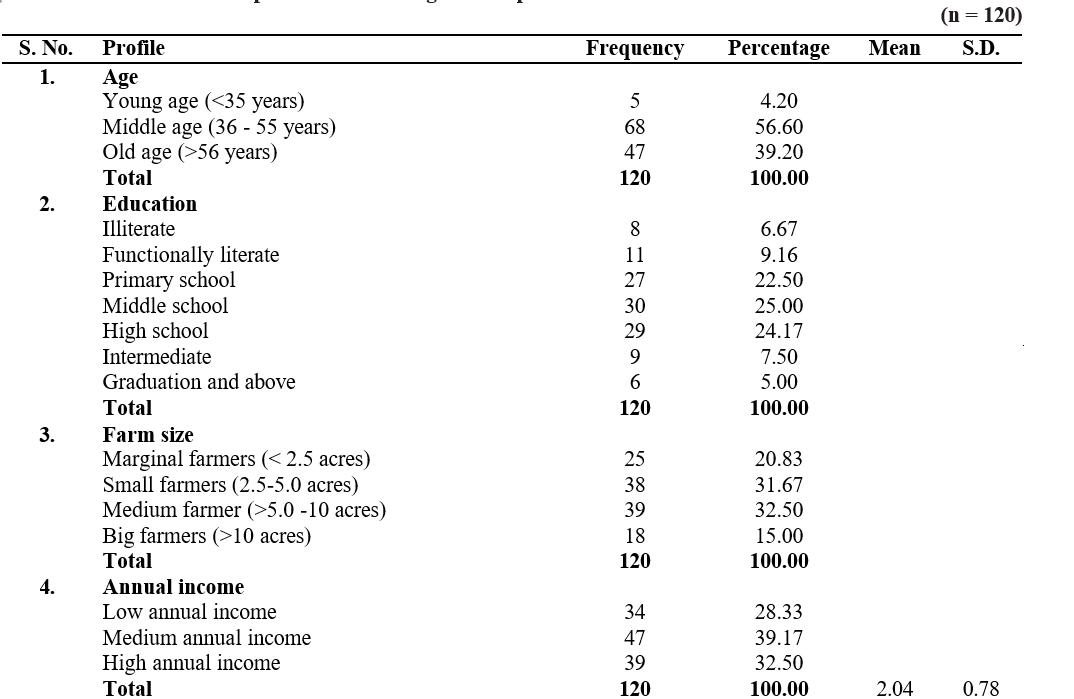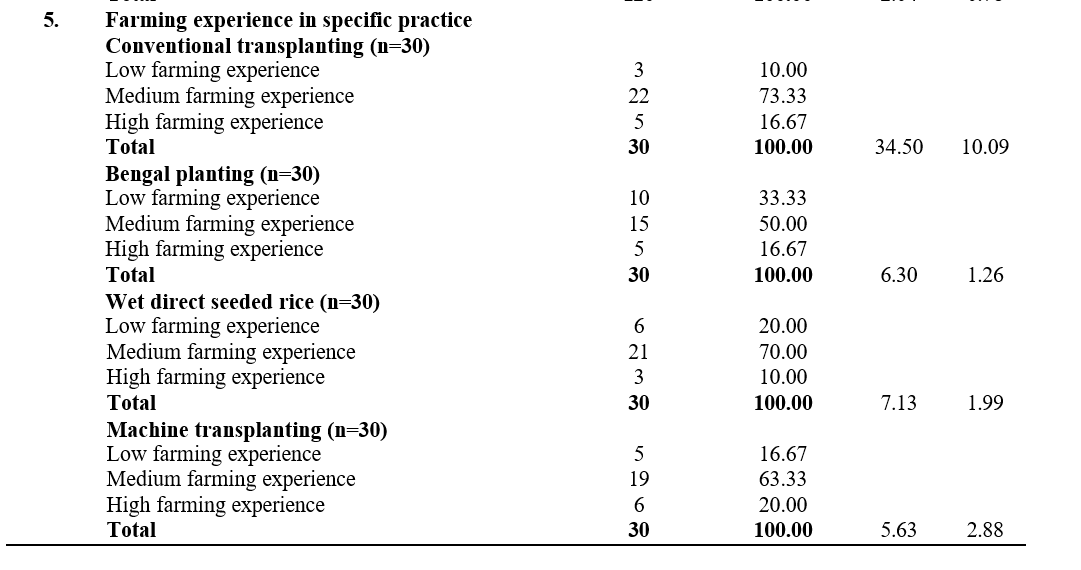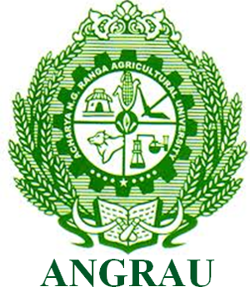Profile of Rice Farmers in East Godavari District of Andhra Pradesh
0 Views
G. LAKSHMI SAHITI SRI MOUNIKA*, P. BALA HUSSAIN REDDY, M.V. KRISHNAJI, N.V. SARALA AND T. LAKSHMI
Department of Agricultural Extension Education, S.V. Agricultural College, ANGRAU, Tirupati-517 502.
ABSTRACT
A study was conducted to understand the efficacy of different rice establishment methods in East Godavari district of Andhra Pradesh as a part of it the profile of rice farmers over a purposive sampling of 120 respondents was investigated. The results of the study revealed that majority of respondents were in the middle age category, with middle school level of education and were medium farmers with medium annual income. Farming experience varied, with most farmers having medium experience levels in their specific method of rice establishment method i.e., conventional transplanting, Bengal planting, wet direct seeded rice, machine transplanting and overall farming had medium level of farming experience, extension contact, innovativeness, scientific orientation, economic orientation and risk orientation.
KEYWORDS: Profile, rice farmers, rice establishment method.
INTRODUCTION
Rice is the leading food crop of the world. In India, transplanting remains the predominant method of rice cultivation, although it is labour intensive and time consuming. The method involves significant costs for uprooting and transplanting the plants, which poses financial challenges to farmers, especially during the peak season when there is a shortage of labour. Farmers are constantly striving to increase their yields and income by adopting various rice establishment methods suited to their particular location. These methods include conventional transplanting, Bengal planting, wet direct seeded rice by broadcasting and mechanical transplanting.
An attempt was made to study socio-economic characteristics of rice farmers practicing four different rice establishment methods in East Godavari district of Andhra Pradesh during 2024.
MATERIALS AND METHODS
Exploratory research design was used for the study. The study was conducted in East Godavari district of Andhra Pradesh state as it is one of the districts in the state having the highest area under rice cultivation. From the district, four mandals namely Nidadavole, Undrajavaram, Anaparthi and Biccavolu were selected purposively based on the highest area under rice cultivation of each method (i.e., Traditional transplanting, Wet direct seeding (broadcasting), Bengal planting and Machine planting). From each of the selected mandals, two villages where any one of the four rice establishment methods practiced were selected thus making a total of eight villages. From each of the selected eight villages, 15 respondents were selected purposively thus making a total of 120 respondents who were engaged in rice cultivation. The data were collected using a well- structured interview schedule. The results of profile of the farmers is merged and presented irrespective of the rice establishment method they are adopting. They were categorized based on the mean and standard deviation for data analysis.
RESULTS AND DISCUSSION
The respondents were distributed into different categories based on their selected profile and results are presented in the Table 1.
Age
Majority (56.60%) of the respondents belonged to the middle age category followed by old age (39.20%) and young age (4.20%) categories. The probable reason might be that the age difference among rice farmers reflects a generational shift in agricultural practices and attitudes towards farming. Similar findings were reported by Deepa (2019).
Education
About 25.00 per cent of the respondents educated upto middle school followed by high school (24.17%), primary school (22.50%), functionally literate (9.16%), intermediate (7.50%), illiterate (6.67%) and graduate and above (5.00%). The possible reason might be due to inadequate financial resources and limited educational facilities in the vicinity of their villages. These findings conform with the results of Phenica (2018) and Rathor (2018).
Farm size
About 32.50 per cent of the respondents belonged to medium farmers category followed by small farmers (31.67%), marginal farmers (20.83%) and big farmers (15.00%) categories. The decline in landholding size among farmers in rural areas can be attributed to the subdivision and fragmentation of farmland from generation to generation. The result is similar to the findings of Phenica (2018).
Annual income
About 39.17 per cent of the respondents belonged to medium annual income category followed by high (32.50%) and low (28.33%) annual income categories. The rice farmers with medium and high-income typically own medium to larger landholdings, which can lead to economies of scale, reducing per-unit costs and increasing profitability and also have better access to advanced agricultural technologies. The findings were in line with the results of Deepa (2019).
Farming experience in specific practice
Majority (73.33%) of the respondents practicing conventional transplanting had a medium level of farming experience followed by high (16.67%) and low (10.00%) farming experience. Under Bengal planting, half (50.00%) of the respondents had a medium level of farming experience followed by low (33.33%) and high (16.67%) levels of farming experience. In wet direct seeded rice, the majority (70.00%) of respondents had a medium level of farming experience followed by low (20.00%) and high (10.00%) levels of farming experience. Regarding machine transplanting, the majority (63.33%) of respondents had a medium level of farming experience followed by high (20.00%) and low (16.67%) levels of farming experience.
Overall farming experience
Majority (65.84%) of the respondents had medium level of overall farming experience followed by low (20.83%) and high (13.33%) levels of overall farming experience. This might be due to the majority of the respondents being middle-aged, which may be a consequence of their medium level of farming experience. These findings conform with the results of Diaka et al. (2024).
Extension contact
Majority (65.00%) of the respondents had medium level of extension contact followed by high (18.33%) and low (16.67%) levels of extension contact. The possible reasons for the above trend might be due to the lack of awareness of extension services or lack of interest in consulting extension officials. The similar findings were confirmed with the results of Rani et al. (2023).
Innovativeness
Majority (60.00%) of the respondents had medium innovativeness followed by high (20.83%) and low (19.17%) levels of innovativeness respectively. The probable reason might be the financial background of the farmer, lack of knowledge and skills in handling the situations hinders the innovativeness of the farmer. The results derived support from the findings of Meshram (2023).
Scientific orientation
Majority (57.50%) of the respondents had a medium level of scientific orientation followed by high (26.67%) and low (15.83%) levels of scientific orientation respectively. This might be due to the farmers were middle-aged and often engaged with extension personnel helped them to adopt the modern rice production technologies specified by the scientists. This result was in agreement with Kumari (2022).
Economic orientation
Majority (60.00%) of the respondents had medium economic orientation followed by high (22.50%) and low (17.50%) levels of economic orientation. The attributes such as illiteracy, exploitation of input dealers, false prestige and excessive ambition might be the reason for the trends described above. These results were in accordance with the findings of Phenica (2018).
Risk orientation
Majority (58.33%) of the respondents had medium level of risk orientation followed by high (25.00%) and low (16.67%) levels of risk orientation. Farmers might tend to imitate by simply adopting the practices of other farmers and incurring high costs instead of adopting innovative approaches and calculated risks. The above finding draws support with the studies of Rani et al. (2023).
The analysis of data revealed that majority of the respondents fell in medium level namely; age, education, farm size, annual income, farming experience in specific practice, overall farming experience, extension contact, innovativeness, scientific orientation, economic
Table 1. Distribution of respondents according to their profile



orientation and risk orientation. The major findings of the study concluded that the proportion of respondents with higher education was low. Additionally, rural youth are increasingly opting for professions other than agriculture. To address this, it is essential to educate and encourage them to engage in farming through agribusiness opportunities. Strengthening the connection between agriculture department officials and farmers is crucial in this regard, as it encourages active participation in extension activities such as meetings, exposure visits, group discussions and demonstrations which enrich the experience and effectiveness.
LITERATURE CITED
Deepa, C. 2019. Input utilization pattern of rice farmers in Nellore district of Andhra Pradesh. M.Sc. (Ag.) Thesis. Acharya N.G. Ranga Agricultural University, Andhra Pradesh.
Diaka, I., Tawiah, J.K and Mensah-Akoto, J. 2024. Smallholder rice farmers information needs and access: An empirical study in the Asunafo North municipality, Ghana. Journal of Rural and Community Development. 19(2): 122–141.
Kumari, B.K., Prasad, S.V., Sailaja, V., Aarna, B and Naidu, G.M. 2022. Profile characteristics of the farmers followed indigenous agricultural practices in Rayalaseema region of Andhra Pradesh. Asian Journal of Agricultural Extension, Economics and Sociology. 40(6): 16-21.
Meshram, S.A. 2023. Knowledge and adoption of rice production technology among the cultivators. M.Sc. (Ag.) Thesis. Vasantrao Naik Marathwada Krishi Vidyapeeth, Parbhani.
Phenica, A.B. 2018. A study on production constraints of rice cultivation in Kurnool district of Andhra Pradesh. M.Sc. (Ag.) Thesis. Acharya N.G. Ranga Agricultural University, Guntur, Andhra Pradesh.
Rani, A.L., Naik, V.R., Reddy, M., Sagar, G.E and Srinivasachary, D. 2023. Profile characteristics of paddy farmers in Telangana State, India. International Journal of Plant and Soil Science. 35(18): 1090-1102.
Rathor, V. 2018. Farmers’ perception towards soil health card in Jabalpur district of Madya Pradesh. M.Sc. (Ag.) Thesis. Jawaharlal Nehru Krishi Vishwa Vidyalaya, Jabalpur.
- Production Potential of Sweet Corn as Influenced by Organic Manures and Foliar Nutrition
- Characterization of Grain Iron and Zinc Content in Little Millet Genotypes
- Faunistic Studies on Economically Important Lepidopterans in Different Field Crops of Tirupati District
- An Annotated Checklist of Cyperceae, Eriocaulaceae and Potamogetonaceae of Chhattisgarh
- Genetic Divergence Studies for Yield, Yield Components and Resistance to Late Leaf Spot in Groundnut (Arachis Hypogaea L.)
- Effect of Organic Farming on Soil Enzymatic Activity and Productivity of Groundnut Based Cropping System

